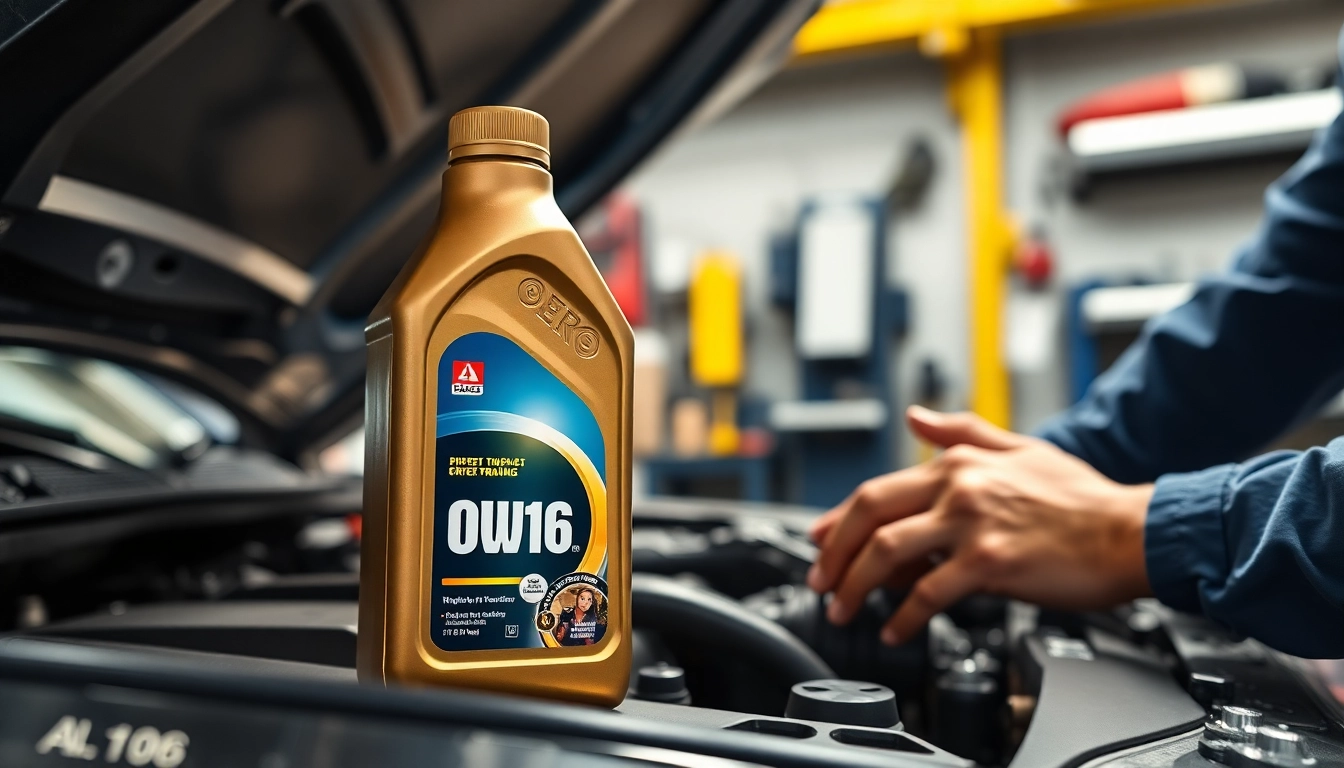
Understanding 0W16 Oil and Its Importance
Motor oil is a crucial component of engine maintenance and performance, serving to lubricate engine parts, reduce friction, and assist in cooling. Among the various grades of motor oil, 0W16 oil has garnered attention, particularly for its suitability in modern engines designed for exceptional fuel efficiency. This high-performing oil offers several benefits that can enhance vehicle longevity and efficiency. In this section, we will delve into what 0W16 oil is, its benefits, and how it stacks up against other oil viscosities.
What is 0W16 Oil?
0W16 oil is a multi-grade synthetic motor oil with a low viscosity rating of 0 when cold and 16 when at operating temperature. This viscosity rating signifies that the oil is thin enough to flow easily during cold starts while providing adequate protection at normal operating temperatures. Engineered primarily for fuel-efficient vehicles, 0W16 oil is specially formulated to enhance engine performance and resilience. The “0W” indicates the oil’s cold-weather performance, allowing it to flow at lower temperatures, while the “16” describes its viscosity at higher engine temperatures.
Benefits of Using 0W16 Oil For Your Vehicle
The utilization of 0W16 oil can yield numerous benefits for vehicle operation and efficiency:
- Enhanced Fuel Efficiency: The thinner viscosity of 0W16 decreases internal engine friction, leading to improved fuel economy, especially in city driving conditions.
- Superior Engine Protection: Engineered to provide exceptional lubricity, 0W16 oil protects engine components against wear and tear caused by high temperatures and operational stresses.
- Cold Weather Performance: With its 0W rating, this oil performs excellently in cold start conditions, ensuring that the engine starts easily without premature wear.
- Reduced Emissions: Because of its efficiency, using 0W16 oil can contribute to lower tailpipe emissions, making it an eco-friendly option for environmentally conscious drivers.
How 0W16 Oil Compares to Other Viscosities
In comparing 0W16 oil to other common viscosity grades, notably 0W20 and 5W20, several differences emerge:
- Viscosity Differences: 0W16 oil is slightly thinner than 0W20, offering less resistance which can lead to better fuel economy while under operational stress.
- Performance Trade-offs: While 0W20 may offer slightly better wear protection due to its thicker composition, 0W16 is optimized for engines designed for maximum fuel efficiency.
- Engine Compatibility: Many modern vehicles, especially hybrids and compact cars, are specifically designed to run on 0W16 oil, allowing them to achieve their peak performance metrics and fuel economy levels.
Selecting the Right 0W16 Oil for Your Engine
When it comes to choosing the right 0W16 oil for your vehicle, it’s important to consider several factors that ensure you are selecting a product that meets both quality standards and manufacturer recommendations.
Top Brands and Their Offerings
Several prominent brands offer 0W16 oil products. Here are a few top contenders worth considering:
- Mobil 1: A recognized leader in synthetic motor oils, Mobil 1 Advanced Fuel Economy 0W16 oil is known for its superior protection against engine wear and its ability to enhance fuel efficiency.
- Valvoline: Valvoline Advanced Full Synthetic Motor Oil SAE 0W16 is formulated to provide max engine protection against sludge and deposits, making it a reliable choice for modern engines.
- Toyota Genuine: For those driving Toyota vehicles, using Genuine Toyota 0W16 oil is recommended to ensure compatibility and maintain warranty coverage.
Considerations for Choosing Quality Motor Oil
When selecting 0W16 oil, keep the following considerations in mind:
- Synthetic vs. Conventional: Always opt for synthetic oils when available, as they provide better stability, longevity, and performance compared to conventional oils.
- API Certification: Look for oils that have an API (American Petroleum Institute) certification, which indicates that they meet specific standards for performance and protection.
- Manufacturer Specifications: Ensure that the oil you choose aligns with the requirements set forth by your vehicle’s manufacturer, often found in the vehicle’s owner’s manual.
Checking Compatibility with Your Vehicle
Before switching to 0W16 oil, double-check your vehicle’s requirements. Compatibility is crucial, as using the wrong oil can lead to engine problems and void warranties. Many newer vehicles are engineered to utilize 0W16 oil specifically, while some older models may not benefit as much from this viscosity grade. Always refer to the owner’s manual and consult with a trusted mechanic if in doubt.
Application and Maintenance Practices
Proper application and maintenance of your vehicle’s motor oil are key to ensuring optimal engine performance and longevity. This section provides insights into how to correctly use 0W16 oil and what routine practices are beneficial.
How to Properly Use 0W16 Oil
Applying 0W16 oil involves understanding the oil change process, including:
- Changing Oil Regularly: Replace your oil as recommended by the manufacturer, typically every 5,000 to 7,500 miles, or as described in your car’s maintenance schedule.
- Drain Old Oil: Ensure the engine is cool before draining the old oil. Use an oil filter wrench to remove the oil filter, and then drain the oil from the oil pan.
- Replace Oil Filter: Always replace the oil filter every time you change the oil to maximize engine protection.
- Fill with New Oil: After draining the old oil and replacing the filter, fill your vehicle with new 0W16 oil, using a funnel for precision.
- Check Oil Levels: After adding new oil, run the engine for a minute and check the oil level with the dipstick, ensuring it is at the proper level.
Signs That You Need an Oil Change
Being vigilant about your vehicle’s oil health is essential. Here are common indicators that it might be time for an oil change:
- Oil Color and Consistency: Fresh oil is typically amber in color; if it appears dark or gritty, it’s time to change it.
- Engine Noise: If you hear unusual noises when the engine is running, it could indicate inadequate lubrication.
- Oil Change Light: Most vehicles have a light that will notify you when it’s time for an oil change.
- Excessive Exhaust Smoke: If your exhaust smoke is darker than usual, it may indicate that the oil is contaminating your engine.
Best Practices for Oil Maintenance
In addition to regular oil changes, maintaining your oil involves the following best practices:
- Regular Checks: Check your oil level at least once a month and top off as needed to prevent engine damage.
- Use Quality Filters: Choose high-quality oil filters; cheap filters can allow contaminants into the engine.
- Monitor Oil Health: Consider using oil analysis services for a detailed report on your oil’s condition and its suitability for continued use.
Environmental Impact of 0W16 Oil
As awareness of environmental responsibility increases, understanding the ecological ramifications of the products we use becomes vital, including motor oil. Synthetic oils, such as 0W16, have distinct environmental benefits worth examining.
Sustainability of Synthetic Oils
Synthetic oils, including 0W16, are engineered to offer more efficient lubrication and longer service life. This improved longevity means less frequent oil changes, contributing to less waste and fewer oil spills. Furthermore, the fuel efficiency associated with using 0W16 oil leads to reduced carbon emissions, making it a greener choice compared to conventional oils.
Recycling and Disposal of Used Motor Oil
Proper disposal of used motor oil is crucial to protect the environment. Many regions provide options for recycling used oil, which can be processed and re-refined for reuse. When changing oil, it is essential to:
- Store Used Oil Safely: Keep used oil in a sealed container until it can be disposed of at a recycling center.
- Follow Local Regulations: Adhere to local laws regarding oil disposal to ensure environmental safety.
- Participate in Oil Recycling Programs: Many automotive shops and service centers offer recycling for used oils.
Choosing Eco-Friendly Options
When selecting motor oils, consumers can choose brands that prioritize sustainability, such as those utilizing recycled materials in their products or those that have low environmental impacts throughout their production processes. Look for certifications such as the EcoLabel or similar locally recognized endorsements to guide you in making environmentally sound choices.
Customer Reviews and Performance Insights
Real-world feedback and performance insights are invaluable when selecting the right motor oil. Here’s what users and experts alike are saying about 0W16 oil.
Real-World Experiences With 0W16 Oil
Many drivers have reported significant improvements in both performance and fuel economy after transitioning to 0W16 oil. For example, users from various forums and communities, such as Toyota Highlander discussions, affirm that using 0W16 oil resulted in quieter engine operation and better fuel mileage. Users switching from higher viscosity oils often notice improved throttle response and smoother running engines.
Comparative Analysis of Popular Products
In a comparative analysis conducted across various 0W16 oil brands, consistently high-rated products include:
- Mobil 1: Known for quality and performance metrics, users highlighted its superior heat protection and ability to maintain viscosity over time.
- Valvoline: Reviews indicated that its advanced formulation offers excellent engine cleanliness and a noticeable difference in engine sound.
Expert Recommendations for Performance Optimization
Experts often recommend a proactive approach, including timely road tests to evaluate oil performance and regular oil inspections. Taking advantage of seasonal oil changes helps optimize vehicle performance, especially in transitional climates where engine temperature fluctuations occur. Moreover, it’s advisable to monitor driving habits and adjust oil changes based on driving conditions—for instance, increasing frequency in stop-and-go traffic or under severe driving conditions.






